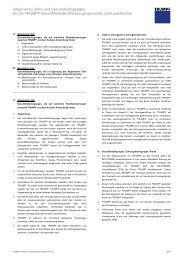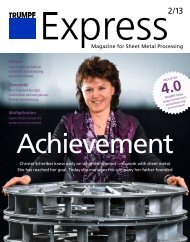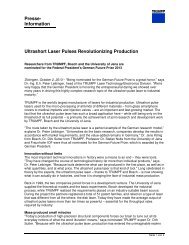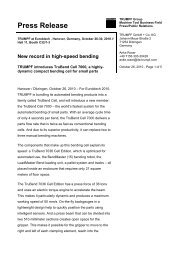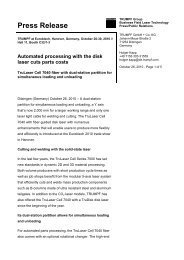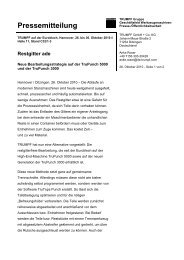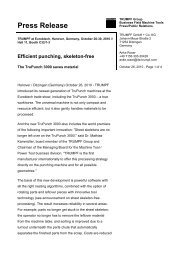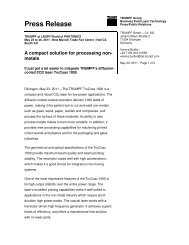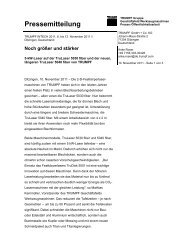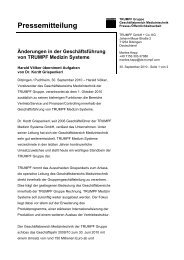Journal - Trumpf GmbH + Co. KG
Journal - Trumpf GmbH + Co. KG
Journal - Trumpf GmbH + Co. KG
You also want an ePaper? Increase the reach of your titles
YUMPU automatically turns print PDFs into web optimized ePapers that Google loves.
A tough<br />
customer<br />
Hardox steel is made to<br />
withstand the most extreme<br />
wear. But this is a quality that,<br />
unfortunately, also comes into<br />
play during processing. Thanks<br />
to the VLM die, the Kreisel<br />
<strong>GmbH</strong> & <strong>Co</strong>. <strong>KG</strong> can bend high-<br />
strength sheet metal as thick as<br />
eight millimeters without major<br />
wear. And when doing so, it<br />
reduces the time required for<br />
bending by two-thirds.<br />
Hardness paired with great toughness —<br />
that’s what makes Hardox steel the preferred<br />
material for the most demanding applications.<br />
But what reduces wear in the final<br />
products — such as dump truck bodies or in<br />
bulk goods handling equipment — can have<br />
unintended and less desirable effects during<br />
machining and manufacture. General Manager<br />
Horst Meister of Kreisel <strong>GmbH</strong> & <strong>Co</strong>.<br />
<strong>KG</strong> knows what he’s talking about.<br />
<strong>Co</strong>nveying bulk goods<br />
takes its toll This family firm,<br />
located in the town of Krauschwitz, near the<br />
Polish border, specializes in products used<br />
in environmentally sound dust reduction<br />
and conveyors for hard-to-handle bulk<br />
goods. One example is a rotary feeder.<br />
Whether it’s a matter of moving cement, fertilizer<br />
or sugar — in China, Vietnam, Russia,<br />
Poland or Germany — the rotary feeders<br />
Technology: Bending<br />
made by Kreisel ensure that the right quantity<br />
of material is introduced to the process<br />
at just the right time. This feeder essentially<br />
is comprised of a rotor to which trough-like<br />
chambers are mounted and which rotates in<br />
a closed housing. The bulk product falls<br />
into one of the chambers through the inlet<br />
opening and exits the chamber at the outlet<br />
port. This enables continuous feed at a specific<br />
volume. But, the insides of the troughs<br />
are exposed to severe loading by the material<br />
— such as cement clinker or lumps of<br />
coal in power plants. Material at a grain size<br />
of up to 150 millimeters is moved through<br />
the rotary feeders.<br />
Horst Meister: “That is the reason for the<br />
high demand for these feeders, particularly in<br />
the building materials industry and in coal<br />
feeding for power plants. This is where the<br />
Hardox material is important to us.” Hardox<br />
plate is used for these chambers and other<br />
Maik Lehmann works with the TrumaBend 320 to shape, in several steps, the material used for the chambers in the rotary feeders.<br />
TruServices <strong>Journal</strong> 02|08 7



